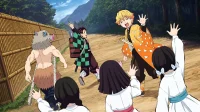Demon Slayer’s Mugen Train: Exploring Missed Character Development Opportunities
The Mugen Train arc of Demon Slayer captivates audiences with its intense action and emotional narratives. While the poignant sacrifice of Rengoku and Tanjiro’s yearning for family capture the viewer’s heart, the series overlooks a significant opportunity to delve deeper into the complexities of Zenitsu and Inosuke. Through the lens of Enmu’s dream manipulation, there lies uncharted potential for character exploration that remains largely untapped.
Dream Sequences: A Window into Characters’ Wishes
The dream sequences in this arc served as perfect vessels to reveal the characters’ innermost desires and fears. For instance, Tanjiro’s dream of being reunited with his slain family highlights his core motivation and emotional struggles. Furthermore, Rengoku’s dreams reflect the profound ties he shares with his family, providing crucial dimensions to his character just before his fateful end.

However, the portrayals of Zenitsu and Inosuke’s dreams fail to explore their backstories meaningfully. Zenitsu finds himself consumed by romantic fantasies about Nezuko, while Inosuke’s battle with a train monster reflects more of his present rather than delving into his roots. By not venturing into their histories, the series loses an essential aspect of their character development.
Zenitsu: Missed Opportunities for Depth
Zenitsu’s turbulent past—marked by abandonment and a complex relationship with his mentor, Jigoro—could have provided fertile ground for impactful storytelling. A dream sequence illustrating Zenitsu’s fear of abandonment or his struggles to live up to Jigoro’s expectations would have offered audiences richer insights into his character arc. Instead, viewers are left with shallow representations that do not illuminate his dual nature of cowardice and brilliance.
Inosuke: A Glimpse into His Origins
In a similar vein, Inosuke’s upbringing in the wild, raised by boars after losing his mother to Doma, could have been woven into his dream sequences. Visual storytelling showcasing interactions with his adoptive boar family, or flashbacks to his mother, could have significantly deepened his character. Such explorations could shine a light on how he developed both his distinct beast breathing style and his competitive yet lonely nature.

Consequences of Shallow Dream Sequences
The primary issue with limiting Zenitsu and Inosuke’s dreams to surface-level encounters is that it undermines their importance in the overarching narrative. This approach positions them as secondary characters reliant on Tanjiro instead of fully fleshed-out individuals with their ambitions and struggles. This deficiency translates into a narrative imbalance, portraying them more like comic relief than nuanced characters.
Conclusion: What Could Have Been
Ultimately, the Mugen Train arc stands out as a remarkable example of storytelling within the anime genre, even while it misses the mark in certain areas. The intense action paired with emotional depth undeniably maintains its appeal to a broad audience. Still, the dream sequences could have offered a more profound experience had they included character explorations akin to those of Tanjiro and Rengoku.
In summary, while Demon Slayer remains a compelling series, the missed opportunities in Zenitsu and Inosuke’s character development reflect a crucial element of storytelling potential that could have enriched the narrative and provided a more holistic portrayal of its ensemble characters.
- Demon Slayer What If: Could Mitsuri Have Trained Zenitsu? Exploring the Possibilities
Source & Images: Sportskeeda


